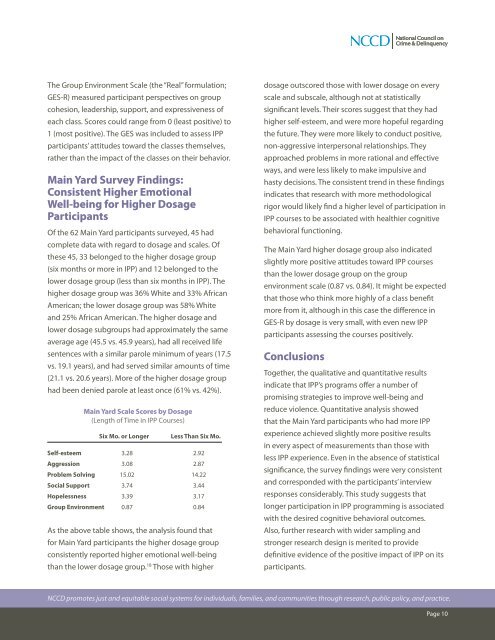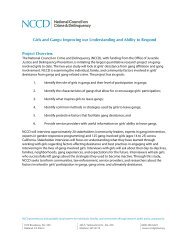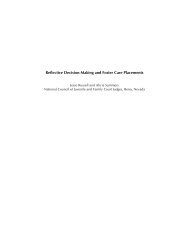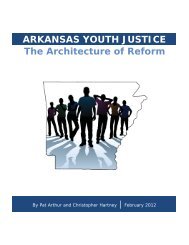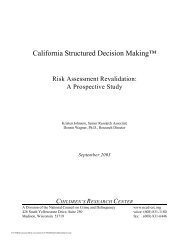Evaluation of the Insight Prison Project - National Council on Crime ...
Evaluation of the Insight Prison Project - National Council on Crime ...
Evaluation of the Insight Prison Project - National Council on Crime ...
You also want an ePaper? Increase the reach of your titles
YUMPU automatically turns print PDFs into web optimized ePapers that Google loves.
The Group Envir<strong>on</strong>ment Scale (<str<strong>on</strong>g>the</str<strong>on</strong>g> “Real” formulati<strong>on</strong>;<br />
GES-R) measured participant perspectives <strong>on</strong> group<br />
cohesi<strong>on</strong>, leadership, support, and expressiveness <str<strong>on</strong>g>of</str<strong>on</strong>g><br />
each class. Scores could range from 0 (least positive) to<br />
1 (most positive). The GES was included to assess IPP<br />
participants’ attitudes toward <str<strong>on</strong>g>the</str<strong>on</strong>g> classes <str<strong>on</strong>g>the</str<strong>on</strong>g>mselves,<br />
ra<str<strong>on</strong>g>the</str<strong>on</strong>g>r than <str<strong>on</strong>g>the</str<strong>on</strong>g> impact <str<strong>on</strong>g>of</str<strong>on</strong>g> <str<strong>on</strong>g>the</str<strong>on</strong>g> classes <strong>on</strong> <str<strong>on</strong>g>the</str<strong>on</strong>g>ir behavior.<br />
Main Yard Survey Findings:<br />
C<strong>on</strong>sistent Higher Emoti<strong>on</strong>al<br />
Well-being for Higher Dosage<br />
Participants<br />
Of <str<strong>on</strong>g>the</str<strong>on</strong>g> 62 Main Yard participants surveyed, 45 had<br />
complete data with regard to dosage and scales. Of<br />
<str<strong>on</strong>g>the</str<strong>on</strong>g>se 45, 33 bel<strong>on</strong>ged to <str<strong>on</strong>g>the</str<strong>on</strong>g> higher dosage group<br />
(six m<strong>on</strong>ths or more in IPP) and 12 bel<strong>on</strong>ged to <str<strong>on</strong>g>the</str<strong>on</strong>g><br />
lower dosage group (less than six m<strong>on</strong>ths in IPP). The<br />
higher dosage group was 36% White and 33% African<br />
American; <str<strong>on</strong>g>the</str<strong>on</strong>g> lower dosage group was 58% White<br />
and 25% African American. The higher dosage and<br />
lower dosage subgroups had approximately <str<strong>on</strong>g>the</str<strong>on</strong>g> same<br />
average age (45.5 vs. 45.9 years), had all received life<br />
sentences with a similar parole minimum <str<strong>on</strong>g>of</str<strong>on</strong>g> years (17.5<br />
vs. 19.1 years), and had served similar amounts <str<strong>on</strong>g>of</str<strong>on</strong>g> time<br />
(21.1 vs. 20.6 years). More <str<strong>on</strong>g>of</str<strong>on</strong>g> <str<strong>on</strong>g>the</str<strong>on</strong>g> higher dosage group<br />
had been denied parole at least <strong>on</strong>ce (61% vs. 42%).<br />
Self-esteem<br />
Aggressi<strong>on</strong><br />
Problem Solving<br />
Social Support<br />
Hopelessness<br />
Group Envir<strong>on</strong>ment<br />
Main Yard Scale Scores by Dosage<br />
(Length <str<strong>on</strong>g>of</str<strong>on</strong>g> Time in IPP Courses)<br />
Six Mo. or L<strong>on</strong>ger Less Than Six Mo.<br />
3.28<br />
3.08<br />
15.02<br />
3.74<br />
3.39<br />
0.87<br />
2.92<br />
2.87<br />
14.22<br />
3.44<br />
3.17<br />
0.84<br />
As <str<strong>on</strong>g>the</str<strong>on</strong>g> above table shows, <str<strong>on</strong>g>the</str<strong>on</strong>g> analysis found that<br />
for Main Yard participants <str<strong>on</strong>g>the</str<strong>on</strong>g> higher dosage group<br />
c<strong>on</strong>sistently reported higher emoti<strong>on</strong>al well-being<br />
than <str<strong>on</strong>g>the</str<strong>on</strong>g> lower dosage group. 18 Those with higher<br />
dosage outscored those with lower dosage <strong>on</strong> every<br />
scale and subscale, although not at statistically<br />
significant levels. Their scores suggest that <str<strong>on</strong>g>the</str<strong>on</strong>g>y had<br />
higher self-esteem, and were more hopeful regarding<br />
<str<strong>on</strong>g>the</str<strong>on</strong>g> future. They were more likely to c<strong>on</strong>duct positive,<br />
n<strong>on</strong>-aggressive interpers<strong>on</strong>al relati<strong>on</strong>ships. They<br />
approached problems in more rati<strong>on</strong>al and effective<br />
ways, and were less likely to make impulsive and<br />
hasty decisi<strong>on</strong>s. The c<strong>on</strong>sistent trend in <str<strong>on</strong>g>the</str<strong>on</strong>g>se findings<br />
indicates that research with more methodological<br />
rigor would likely find a higher level <str<strong>on</strong>g>of</str<strong>on</strong>g> participati<strong>on</strong> in<br />
IPP courses to be associated with healthier cognitive<br />
behavioral functi<strong>on</strong>ing.<br />
The Main Yard higher dosage group also indicated<br />
slightly more positive attitudes toward IPP courses<br />
than <str<strong>on</strong>g>the</str<strong>on</strong>g> lower dosage group <strong>on</strong> <str<strong>on</strong>g>the</str<strong>on</strong>g> group<br />
envir<strong>on</strong>ment scale (0.87 vs. 0.84). It might be expected<br />
that those who think more highly <str<strong>on</strong>g>of</str<strong>on</strong>g> a class benefit<br />
more from it, although in this case <str<strong>on</strong>g>the</str<strong>on</strong>g> difference in<br />
GES-R by dosage is very small, with even new IPP<br />
participants assessing <str<strong>on</strong>g>the</str<strong>on</strong>g> courses positively.<br />
C<strong>on</strong>clusi<strong>on</strong>s<br />
Toge<str<strong>on</strong>g>the</str<strong>on</strong>g>r, <str<strong>on</strong>g>the</str<strong>on</strong>g> qualitative and quantitative results<br />
indicate that IPP’s programs <str<strong>on</strong>g>of</str<strong>on</strong>g>fer a number <str<strong>on</strong>g>of</str<strong>on</strong>g><br />
promising strategies to improve well-being and<br />
reduce violence. Quantitative analysis showed<br />
that <str<strong>on</strong>g>the</str<strong>on</strong>g> Main Yard participants who had more IPP<br />
experience achieved slightly more positive results<br />
in every aspect <str<strong>on</strong>g>of</str<strong>on</strong>g> measurements than those with<br />
less IPP experience. Even in <str<strong>on</strong>g>the</str<strong>on</strong>g> absence <str<strong>on</strong>g>of</str<strong>on</strong>g> statistical<br />
significance, <str<strong>on</strong>g>the</str<strong>on</strong>g> survey findings were very c<strong>on</strong>sistent<br />
and corresp<strong>on</strong>ded with <str<strong>on</strong>g>the</str<strong>on</strong>g> participants’ interview<br />
resp<strong>on</strong>ses c<strong>on</strong>siderably. This study suggests that<br />
l<strong>on</strong>ger participati<strong>on</strong> in IPP programming is associated<br />
with <str<strong>on</strong>g>the</str<strong>on</strong>g> desired cognitive behavioral outcomes.<br />
Also, fur<str<strong>on</strong>g>the</str<strong>on</strong>g>r research with wider sampling and<br />
str<strong>on</strong>ger research design is merited to provide<br />
definitive evidence <str<strong>on</strong>g>of</str<strong>on</strong>g> <str<strong>on</strong>g>the</str<strong>on</strong>g> positive impact <str<strong>on</strong>g>of</str<strong>on</strong>g> IPP <strong>on</strong> its<br />
participants.<br />
NCCD promotes just and equitable social systems for individuals, families, and communities through research, public policy, and practice.<br />
Page 10


